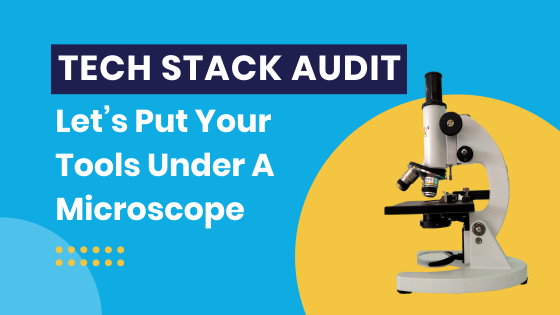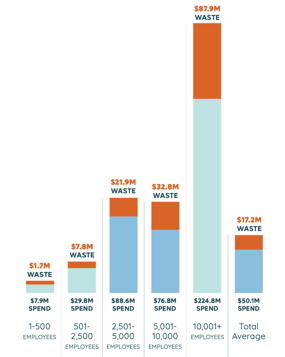


Tech Stack Audit: Let's Put Your Tools Under a Microscope




Have you ever considered whether your tech stack could potentially be the cause of inefficient operations?
Your stack may have the industry's best tools to support your marketing, sales, customer service, internal operations and other crucial aspects of the business. But when you look at it from the perspective of an ecosystem, you have to ensure that all your tools integrate seamlessly with each other to eliminate inefficiencies.
Let's take a step back to discuss how a tech stack audit can benefit your organisation, and how can you perform it.
What is a Tech Stack?
Anything and everything you use to support your business operations encompasses your tech stack.
From Martech (marketing technology) to any sales enablement software, or from customer service platforms to internal communication systems - every tool or software you use comes together to form your tech stack.
%20(1000%20x%20500%20px).png?width=642&height=321&name=Wasted%20Time%20(600%20x%20270%20px)%20(1000%20x%20500%20px).png) Tools in a Tech Stack
Tools in a Tech Stack
Over the last couple of years, especially with the rise of RevOps, there has been a significant change in the way businesses prioritise operational efficiency. The RevOps Flywheel model helped us gain insights to achieve that through a few simple strategies:
- Increased collaboration and alignment among teams
- Less is more
- Centralised information
- Process optimisation
- Continuing training and development
When applied to the third pillar of RevOps a.k.a. technology, businesses cannot only reduce costs associated with unnecessary tools but also enhance the overall synergy and effectiveness of their GTM strategy.
This is where a tech stack audit comes in. By conducting a thorough evaluation of your tech stack, you can identify any gaps or redundancies and make necessary adjustments to optimise your operations. A modern tech stack should be streamlined, efficient, and scalable, allowing for smooth collaboration and improved productivity.
Why Do You Need a Tech Stack Audit?
![]()
1. Siloed data hinders collaboration and alignment
Reiterating what we said earlier, simply having the best tools at your disposal does not guarantee success. If your tech ecosystem does not seamlessly integrate all your tools, it can lead to data silos causing inefficiencies, duplicate efforts, and wasted time and resources.
Effective internal communication is vital for achieving organisational goals. However, when each department uses its technology without integration capabilities, it hampers alignment and collaboration among teams. This can divert teams from their long-term organisational objectives, causing them to focus solely on their individual departmental goals.
Furthermore, if teams are not accessing data from the same source, it becomes difficult to determine overall success and discern what strategies are effective.
2. Fragmented customer journey
When data silos occur and departments within an organisation are not aligned, it creates a fragmented customer journey that can hinder effective communication with customers. Without a unified view of the customer's interactions and touchpoints, it becomes difficult to understand their needs and preferences.
Deprived of this, sales and marketing teams aren't able to provide personalised experiences and customers expecting fluidity across touchpoints, encounter disruptions that erode satisfaction and loyalty.
3. Underutilised tools draining your budget
Have trouble explaining the amount your tech stack takes up in your yearly budget?
We often tend to jump and invest in new tools that are either new in the market (which most of us can easily get attracted/compelled to use) or have 'productivity' or 'efficiency' associated with them. Rather than looking at it holistically from the perspective of a tech ecosystem, in other words investing in tools that are multifunctional and have integration capabilities, we keep on increasing our tech stack pyramid. This causes a detrimental impact on an organisation's budget which can lead to financial strain.
Although some of these tools may have seemed interesting when they were freshly invested in, they tend to lose their spark over time and are pushed into a dark corner where nobody bothers using them. This underutilisation can be clearly seen in the graph below taken from Zylo's report on SaaS management, where they shed light on the amount of tech that goes to waste within companies of different sizes.
 Source: Zylo 2023 SaaS Management Index Report
Source: Zylo 2023 SaaS Management Index Report
4. Bad data is hindering progress
Ensuring the integrity of data within your tech stack is crucial for making informed decisions. However, it's important to address challenges related to security concerns and data inconsistencies that can pose potential pitfalls.
With an increasing number of security breaches and concerns about data privacy, organisations often feel compelled to review and strengthen their security measures within their tech stack.
At the same time, data inconsistencies can lead to inaccuracies in reporting and disparities across different tools, making it difficult to obtain a unified view of customer data.
This presents a significant challenge that organisations need to prioritise, not only to mitigate security risks but also to ensure reliable and cohesive insights for strategic decision-making.
5. Outdated tech is affecting scalability
You can't spell growth without optimisation.
Technology plays a crucial role in streamlining processes and workflows, but the impact of an inefficient tech stack on scalability cannot be underestimated.
When you fail to audit or review your tech stack from time to time you're limiting yourself to existing resources that may not be as efficient and productive as others might be, which hampers growth and scalability.
This challenge is further compounded by security and compliance considerations, as outdated systems become vulnerable to risks. It is essential to address these security risks associated with an outdated tech stack, especially in today's strict regulatory landscape where compliance is non-negotiable.
6. Decreased productivity and frustration among employees
Imagine trying to navigate through a complex web of tools, wasting valuable time and disrupting your workflow. This is the kind of inefficiency that can arise from a poorly optimised tech stack.
And the frustration doesn't end there – employees who have to deal with clunky tools often experience a decrease in productivity and satisfaction. They find themselves constantly reaching out for technical support, taking their focus away from their core responsibilities.
This dissatisfaction isn't limited to just the organisation; it extends to stakeholders, including employees and customers, who express their discontent. It's like hearing a collective sigh of frustration with the current state of the tech environment. Addressing these issues isn't solely about technology; it's about fostering a positive and efficient work culture that resonates with everyone involved in the journey.
Overall, a thorough tech stack audit proves to be a strategic investment in optimising efficiency, reducing costs, and fortifying the security of your business operations.
How to Perform a Tech Stack Audit?
Now that we've covered what is a tech stack, and how would you benefit from auditing it; let's dive into how to actually perform a tech stack audit:
1. Comprehensive Inventory:
Begin the audit by compiling a comprehensive list of all the tools currently being utilised across various departments. This inventory will serve as the cornerstone for conducting a meticulous analysis of the entire tech stack.
2. Functional Analysis:
Explore the functionalities of each tool and gain an understanding of its role, features, and how it contributes to operational processes. This analysis offers valuable insights into whether a tool aligns with the current needs of your business.
3. Functional Grouping:
Categorise tools with similar functionalities to identify any redundancies and streamline operations. This step will help you identify any overlaps, eliminate duplicate tools, and create a more efficient tech ecosystem.
4. Utilisation Assessment:
Assess the usage of each tool and pinpoint any that are being underutilised or not used at all. Consider the value these tools bring to the organisation and whether their functionalities can be substituted or integrated into more comprehensive solutions.
5. Integration Evaluation:
Examine the integration capabilities of each tool. Evaluate how effectively they work together to form a unified and harmonious tech ecosystem. Identify any potential gaps or conflicts in integration and prioritise tools that seamlessly complement each other.
6. Optimisation and Implementation:
Once you have gained a clear understanding of the role, functionality, and integration capabilities of each tool, it is time to optimise your tech stack to align with your organisational goals. Implement strategic changes to ensure that the revised stack not only meets your current needs but also supports future scalability and growth.
What Should a Modern Tech Stack Look Like?
In conclusion, it is crucial for the efficiency and success of your business operations to have a harmoniously integrated tech stack.
A modern tech stack goes beyond being a mere collection of industry-leading tools; it is an ecosystem that seamlessly integrates to eliminate inefficiencies. As discussed earlier, a comprehensive tech stack audit helps you uncover these inefficiences that hide in plain sight and helps initiate the process to build an effective tech stack.
So, what should a modern tech stack look like?
It should be streamlined, efficient, and scalable, enabling collaboration, reducing costs, and fortifying security. As we have explored the challenges, such as siloed data, fragmented customer journeys, underutilized tools, bad data, and outdated tech, the importance of a cohesive and optimized tech stack becomes evident. By addressing these challenges, a well-audited and modern tech stack becomes a cornerstone of operational excellence, paving the way for sustained growth and success.








